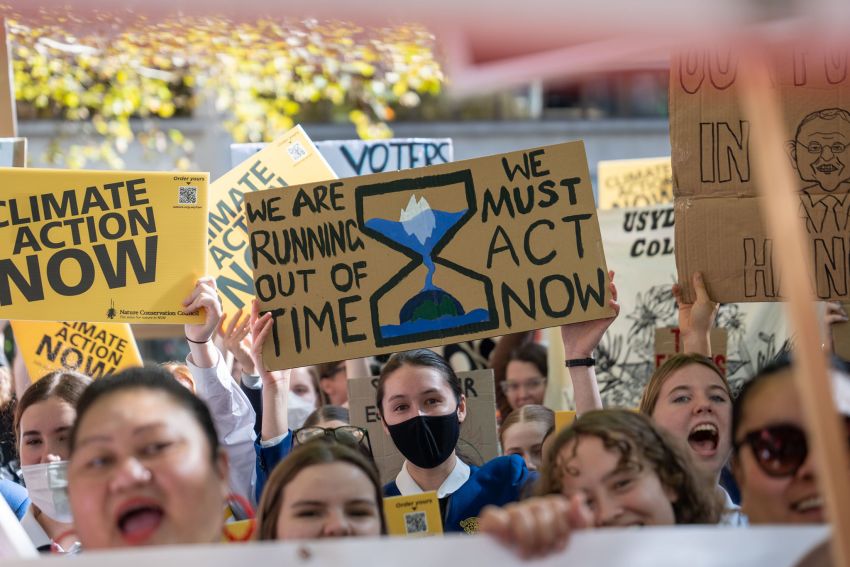
Climate activists pointed out that Labor’s 43% target for carbon emission reductions by 2030 was woefully inadequate before it became law. Now, Labor is promoting its “strengthened” “safeguard mechanism” to cover for the meaningless target.
Labor is acting like it can argue with physics. It can’t.
The climate crisis is the result of human activity: since industrialisation, too much carbon dioxide and other greenhouse gas emissions have been released into the atmosphere. The only solution for a safe climate is to reduce the emissions to zero as soon as possible.
Labor’s safeguard mechanism policy is designed to enable carbon pollution to not only continue, but increase, at 215 of the country’s largest emission sites. The government wants to look like it is dealing with the climate crisis while cosying up to the fossil fuel giants.
There are four big problems with Labor’s proposed safeguard mechanism.
1. Unlimited offsets
Labor claims that an amended version of Tony Abbott’s safeguard mechanism will limit emissions from the big polluters. Those sites which emit more than 100,000 tonnes of carbon dioxide in one year is incorporated into the scheme.
A big problem is that these polluters can buy cheap carbon credits, instead of reducing emissions.
Consider the example of a company running a gas-fired power station. Most would assume that cutting emissions would mean it would shift its investment to start producing power from renewable energy. But, under Labor’s safeguard mechanism, this company will be able to continue polluting, even increase it, as long as it buys carbon credits.
In theory, the carbon credits allow pollution in one location to be “offset” by pollution reductions in other places.
In practice, the carbon credits are frequently “dodgy” and involve: false claims about reduced emissions; temporary, instead of permanent, emission reductions; promises not to raise emissions instead of actual reductions; as well as other dubious accounting tricks.
Even where carbon credits are the result of emission reductions, “offsetting” emissions fails to solve the problem of carbon pollution. Avoiding a climate catastrophe means reducing all emissions to zero as soon as possible.
Climate Analytics’ recently published Why offsets are not a viable alternative to cutting emissions concluded that the use of offsets will “likely” allow “real emission increases” — not reductions.
2. High baselines
The safeguard mechanism, introduced by then Coalition climate minister Greg Hunt, included high baselines — way above what polluting companies were already emitting. Labor’s plan is to modify these, but it will still be “enforcing” reductions from levels higher than are currently emitted.
Labor has structured its policy to make it look like progress is being made — without it actually being the case. It gives a lot of wriggle room to the fossil fuel corporations and their armies of lobbyists and greenwashers.
3. Reducing 'intensity' not actual emissions
Another dubious feature of the safeguard mechanism is that it measures the “intensity” of emissions rather than total emissions.
This means that a fossil fuel corporation could expand production but still be given credits under the safeguard mechanism if the percentage of emissions has decreased slightly.
The experience of many industries shows that greater energy efficiency (reduced “intensity” of emissions) can co-exist with increased total pollution.
Take the car industry as an example. Fuel economy has greatly improved over the last 70 years. However, this has not led to reduced emissions from transport because, as the United Nations Environment Programme put it, “efficiency gains have been countered by the use of larger vehicles, and increases in car numbers and distances travelled”.
The big fossil fuel companies prefer targets based on intensity of emissions, instead of the absolute volume of emissions, because they know that they can easily reduce the former while increasing the latter.
This is how the proposal allows — even encourages — increases in total emissions.
4. Diverting investment away from renewables
The focus on carbon credits and offsets diverts investment funds away from the necessary transition to renewable energy.
Delay or Decarbonise? Australia’s climate policy trade-off, a report by The Australia Institute (TAI), found that investment in new renewable energy generation had declined by 50% since 2018. Then, the Renewable Energy Target (RET) promoted such investment. Once achieved, the policy pressure (such as it was) towards investment in renewables, evaporated.
By contrast, the volume of carbon offset projects registered last year is roughly double what it was in 2020 and 2021.
The safeguard mechanism actively encourages big companies to “invest” funds in dubious carbon credits and offsets, instead of directly investing in decarbonisation. TAI executive director Richard Dennis described it as “about the most economically inefficient thing” he could think of.
Finally, it is worth remembering that Labor’s safeguard mechanism does not even attempt to deal with “scope three” emissions — the emissions that come from burning Australia’s fossil fuels exports.
Reducing domestic emissions — some of the highest per capita in the world — is important. At least as important is a rapid replacement of fossil fuel exports with benign energy to meaningfully contribute to averting the climate catastrophe.
Ketan Joshi in Renew Economy criticised Labor’s safeguard mechanism as “designed to make things worse”. “Every trick that features in the climate plans of the planet’s worst emitters features in the safeguard mechanism,” he said.
Climate Analytics said the “unfettered use of offsets under the Safeguard mechanism will likely allow real emission increases (as opposed to reductions) in Australia, and their use will have adverse implications for global emissions”.
The safeguard mechanism should be scrapped and replaced with a policy designed to reduce emissions. Importantly, this should include a ban on new fossil fuel developments, something Labor is so far refusing to consider.